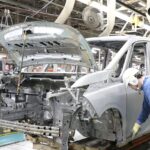The final glimpse of Saturn by Cassini-Huygens spacecraft

Probe crashed into the planet in 2017
NASA’s Cassini-Huygens spacecraft delivered this breathtaking natural colour image of Saturn and its intricate rings en route to its orbital destination.
Before insertion into the planet’s orbit, this last snapshot taken on March 27, 2004, reveals a palette of hues across Saturn’s southern hemisphere, subtle colour variations within the middle B ring, and a striking blue sparkle in the north. Scientists explain this phenomenon as sunlight piercing Saturn’s Cassini Division and scattering as it interacts with the planet’s upper atmosphere.
Weighing in at 571kg, Cassini-Huygens is one of the heaviest planetary probes ever launched by NASA.
Its journey began on October 15, 1997, atop a Titan IVB/Centaur rocket from Cape Canaveral Air Force Station, Florida. Initially deemed too massive for a direct route to Saturn, the spacecraft navigated a seven-year odyssey punctuated by gravity assists from Venus (twice), Earth, and Jupiter. Each slingshot manoeuvre boosted its speed, culminating in a historic arrival at Saturn on July 1, 2004.
Cassini initiated a pivotal 96-minute engine burn that day, settling into an elliptical orbit around Saturn. This landmark achievement marked Cassini as the first spacecraft to achieve such a feat, commencing an unprecedented 13-year mission to scrutinise Saturn, its rings, and its moons.
Over this duration, Cassini’s investigations yielded a trove of discoveries that have expanded humanity’s understanding of this distant gas giant and its celestial entourage.
Mission end
The Cassini mission ended in 2017 when NASA intentionally plunged the probe into Saturn. This dramatic conclusion was a precautionary measure aimed at preserving the pristine environments of Saturn’s moons for potential future explorations.
Saturn continues to captivate astronomers and space enthusiasts with its enigmatic beauty and scientific intrigue. This gas giant, named after the Roman god of agriculture, boasts a distinctive ring system that sets it apart from all other planets in our cosmic neighbourhood.
At approximately 9.5 times the Earth’s diameter, Saturn is primarily composed of hydrogen and helium, with swirling clouds of ammonia and methane in its atmosphere. One of its most striking features is its expansive ring system, consisting of icy particles ranging from dust-sized grains to mammoth chunks of ice several metres across.
These rings, considered remnants of comets, asteroids, or shattered moons, orbit Saturn in a mesmerising display that has fascinated astronomers since Galileo first glimpsed them through a telescope in the 17th century.
Saturn also hosts a diverse array of moons, each with unique characteristics and mysteries waiting to be unravelled. Titan, Saturn’s largest moon, is exciting due to its dense atmosphere and lakes and rivers of liquid methane and ethane on its surface.
As space exploration advances, Saturn remains a focal point for scientific discovery, offering insights into the formation and evolution of our solar system and beyond.
Featured image: The final image of Saturn taken by NASA’s Cassini-Huygens spacecraft. Credit: NASA/JPL/Space Science Institute













